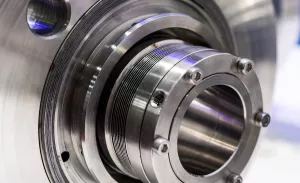Quad Seals/X-Rings vs O-Rings: Key Differences & Which Should You Use?
When choosing a sealing solution for your machinery or components, O-rings are usually the top choice. But have you thought about quad rings, also known as X-rings? These seals have unique advantages in certain applications. In some cases, they even outperform standard O-rings.
In this blog, we will explore the differences between quad seals and O-rings, their pros & cons, and when one is better for your equipment
What Are O-Rings?
O-rings are circular rubber seals with a round cross-section, which are widely used across many industries from automotive and aerospace to food production and hydraulics. They are simple, cost-effective, and work well in various types of applications.
Benefits of O-Rings:
• Easy to install and replace
• Available in a wide range of sizes and materials
• Affordable and reliable for static and dynamic sealing
• Suitable for both low- and high-pressure environments
While O-rings are incredibly versatile, they’re not always perfect. This is especially true in high-motion or high-pressure dynamic systems.
What Are Quad Seals/X-Rings?
Quad seals also know as X-Rings have a four-lobed profile instead of a round cross-section. This unique shape helps them overcome some limitations of traditional O-rings—especially in demanding dynamic applications.
Benefits of Quad Seals (X-Rings):
• Improved sealing efficiency: The four-lobed shape provides multiple sealing surfaces.
• Reduces rolling or twisting: This is particularly useful in reciprocating applications where O-rings might fail.
• Lower friction and wear: Their geometry allows for better lubrication retention.
• Longer lifespan: Less wear and better stability lead to extended service intervals.
X-Rings vs O-Rings: Key Differences
Feature |
O-Rings |
Quad Seals/X-Rings |
Cross-section shape |
Round |
Four-lobed (X-shaped) |
Sealing surfaces |
One main point of contact |
Two points of contact |
Stability in motion |
May twist or roll |
Resists twisting and rolling |
Friction level |
Higher in dynamic use |
Lower due to improved lubrication |
Leak prevention |
Good in static seals |
Better in dynamic or moving parts |
Cost |
Lower upfront |
Slightly higher, but longer life |
Best for |
Static sealing, low-cost needs |
Dynamic applications, high pressure |
When Should You Use a Quad Seal Instead of an O-Ring?
Quad seals are highly used in dynamic applications for example pistons, rotary shafts, or valves that move under pressure. If your equipment has issues with leakage, seal extrusion, or premature wear, switching to a quad seal could lead to significant improvements.
Ideal use cases for X-rings include:
• Reciprocating hydraulic or pneumatic systems
• Environments where standard O-rings twist or degrade
• High-speed rotating shafts
• Applications requiring extended sealing performance
When to use O-Rings over Quad Seal/ X-Rings
Despite their limitations, O-rings are still the best choice in many situations. They work well when the seal is static, costs need to stay low, or there isn't much space for more complex shapes.
You should stick with O-rings when:
• The application is low-pressure and static
• There’s minimal or no motion between components
• You’re looking for a low-cost, easy-to-source solution
• You already have standard O-ring groove designs
Frequently Asked Questions
Are X-rings more reliable than O-rings?
In dynamic systems, yes. Their resistance to twisting and improved lubrication make them more durable under motion.
Can I replace an O-ring with a quad seal in the same groove?
Not always. While they often fit the same groove, some quad seals need slightly different groove dimensions. Always check the specs before making a switch.
Do X-rings cost more than O-rings?
Typically yes, but the cost difference is balanced by longer seal life and fewer replacements.
What materials are available for quad seals?
They are commonly made from Nitrile (NBR), Viton (FKM), EPDM, and Silicone—just like O-rings.
Do quad seals work in high-temperature environments?
Yes, as long as they are made from high-temperature materials like Viton or Silicone.
Which Seal Is Best for You?
If you're sealing something simple and static, an O-ring will likely work just fine. But if you’re dealing with movement, pressure, or wear—and you want to avoid frequent seal failures—quad seals (X-rings) could be a smart choice.
Each seal type has its place. Understanding your application’s requirements is the key to making the right choice.
Need help selecting the right seal for your project? Get in touch with our team—we’ll help you find a sealing solution that meets your performance and reliability needs.
What to read next...

Do Mechanical Seals Need Lubrication? What Every Engineer Should Know
Read more
Chemical Processing Safety: How Seal Failures Lead to 34% of Industrial Accidents
Read moreSign up to our newsletter
Don't forget to subscribe to our newsletter to receive details of our latest special offers and new products.
Darlington
Telephone: +44 (0) 1325 282732 Email: sales@fpeseals.com
Doncaster
Telephone: +44 (0) 1302727252 Email: doncaster@fpeseals.com
Aberdeen
Telephone: +44 (0) 1224648999 Email: sales@swanseals.co.uk
The Netherlands
Telephone: +31 (0) 162581060 Email: info@fpeseals.com

